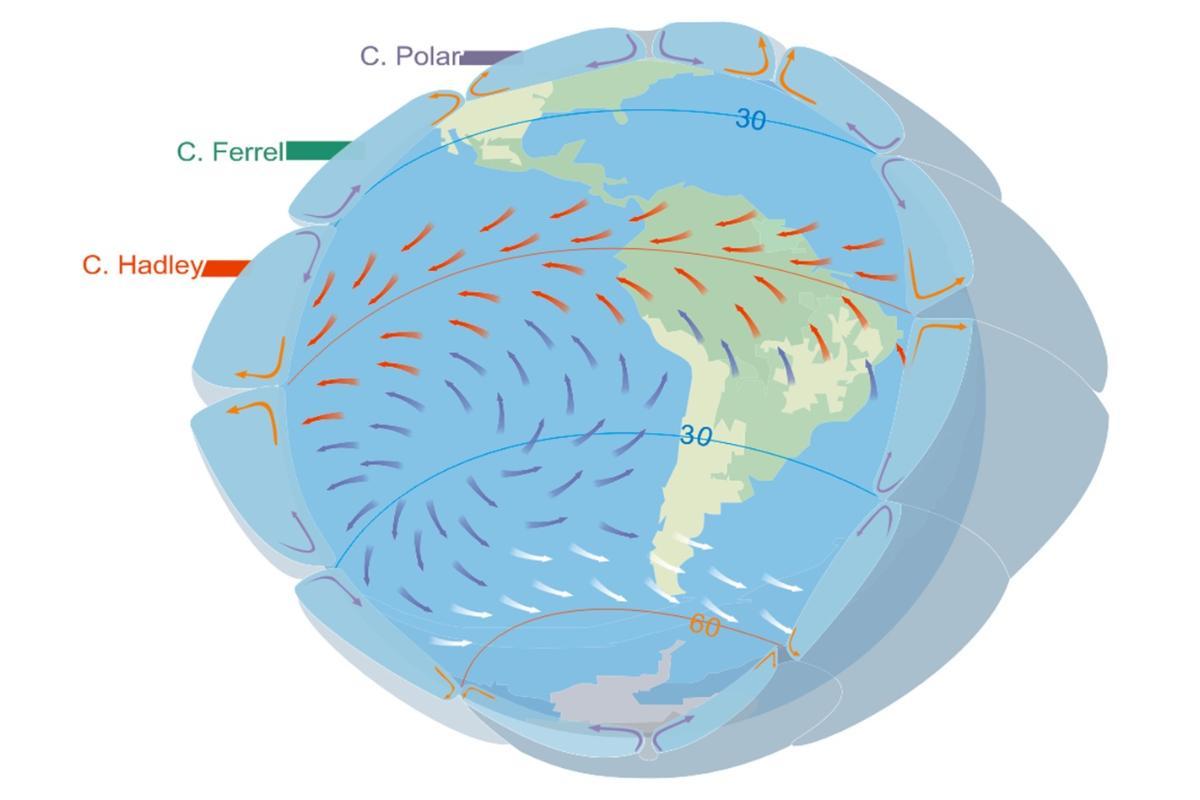What Is General Atmospheric Circulation?


The Earth's atmosphere is in constant motion, driven by the uneven heating of the planet's surface by the sun. This dynamic movement, known as general atmospheric circulation, shapes global wind patterns, influences climate zones, and affects weather systems around the world. Understanding these circulation patterns is essential for grasping how energy and moisture are transferred across the planet, leading to phenomena like trade winds, jet streams, and monsoons.
In this article by thedailyECO, we’ll explain what general atmospheric circulation is, break down the mechanisms behind global wind patterns and explain how they influence both local weather and the broader climate system.
What is atmospheric general circulation?
General atmospheric circulation refers to the large-scale movement of air in the Earth's atmosphere, primarily driven by the uneven heating of the planet's surface by the sun. However, it is also driven by the Earth's rotation, and the presence of landmasses and oceans.
This process results from temperature and pressure differences across various regions of the planet, creating wind patterns that transport heat from warmer areas near the equator to colder regions near the poles.
The circulation system consists of a series of major circulation cells repeated in each hemisphere: the Hadley, Ferrel, and Polar cells. Together, these cells regulate the distribution of heat and moisture around the globe, playing a crucial role in shaping weather patterns and climate.
Atmospheric circulation is responsible for a wide range of weather phenomena, including:
- Storms: hurricanes, tornadoes, and other severe weather events are often driven by atmospheric circulation patterns.
- Temperature: the movement of air masses can influence temperature variations across regions.
- Precipitation: atmospheric circulation plays a crucial role in determining precipitation patterns, such as rainfall and snowfall.
Ever wondered why some winds bring sudden warmth to certain regions? Explore the fascinating science behind this weather effect in our other article on the Foehn effect.
How atmospheric general circulation occurs
As mentioned earlier, general atmospheric circulation is a large-scale system that redistributes heat and moisture across the planet. This process plays a critical role in shaping global weather patterns and climate. It can be broken down into several key stages:
1. Solar radiation and uneven heating
The Earth’s spherical shape and axial tilt result in uneven solar heating. The equator receives direct sunlight year-round, making it much warmer than the poles, which receive less concentrated sunlight.
This disparity creates a thermal gradient, with warm air concentrated near the equator and cooler air near the poles. Seasonal variations, caused by the tilt of the Earth’s axis, also affect the intensity and distribution of solar energy, influencing the atmospheric circulation throughout the year.
2. Atmospheric convection
Warm air at the equator heats up, becomes less dense, and rises, creating a zone of low pressure at the surface. This rising air cools as it ascends into the upper atmosphere, leading to cloud formation and precipitation, a process that drives tropical rainforests in the equatorial region.
As the air continues to move poleward at high altitudes, it cools further. Conversely, at the poles, cold, dense air sinks, creating high-pressure zones. This sinking air eventually flows back toward the equator, completing the circulation loop.
3. Formation of circulation cells
The rising and falling of air due to convection creates three major circulation cells in each hemisphere. These are:
- Hadley Cell: near the equator, with air rising and descending at subtropical latitudes.
- Ferrel Cell: between the Hadley and Polar cells, moving air from mid-latitudes toward the poles.
- Polar Cell: near the poles, circulating cold air toward lower latitudes.
These three major circulation cells help redistribute heat and moisture around the globe. We will discuss them in more detail below.
4. Jet streams
High-altitude, fast-moving air currents known as jet streams form at the boundaries between circulation cells, particularly between the Hadley and Ferrel cells, and the Ferrel and Polar cells. These jet streams influence weather patterns and can drive the development and movement of storms across continents.
Wondering what qualifies as a ‘strong wind’? Find out how we define it in our related article.

Global wind systems and atmospheric circulation cells
The general circulation of the atmosphere establishes several key wind systems that follow distinct global patterns. These winds vary by latitude and are associated with the three primary atmospheric circulation cells:
Trade Winds (Hadley Cell)
The trade winds are steady, warm air currents that blow from the subtropical high-pressure zones around 30° North and South latitudes towards the equator. They are generated by the descending air at these latitudes, which creates high-pressure areas.
The trade winds are deflected westward by the Coriolis effect, causing them to blow from the northeast in the Northern Hemisphere and from the southeast in the Southern Hemisphere. These winds are crucial for maritime navigation and contribute to the formation of tropical weather systems.
Westerlies (Ferrel Cell)
The westerlies are prevailing winds that blow from the west in the mid-latitudes, between approximately 30° and 60° North and South. They result from the interplay between the descending air at the subtropical high-pressure zones and the rising air near the subpolar low-pressure zones.
These winds are responsible for much of the weather variability experienced in temperate regions, as they guide weather systems from west to east across continents.
Polar Easterlies (Polar Cell)
In the polar regions, cold, dense air descends, creating high-pressure zones at the poles. This air then flows toward lower latitudes, but is deflected westward by the Coriolis effect, forming the polar easterlies. These winds blow from east to west and are typically weak and irregular, but they play a role in driving cold air masses toward the mid-latitudes, influencing winter weather patterns in those areas.

The Coriolis effect
The Coriolis effect, a consequence of Earth's rotation, significantly influences atmospheric circulation. It causes winds and ocean currents to deviate from a straight path, leading to the prevailing wind patterns we observe.
As air moves through the atmosphere, the Earth's rotation deflects it. This deflection is crucial in understanding why winds don't simply flow directly from high-pressure to low-pressure areas.
Interestingly, the Coriolis effect operates differently in the Northern and Southern Hemispheres:
- Northern Hemisphere: polar winds are deflected to the right, blowing from east to west.
- Southern Hemisphere: polar winds are deflected to the left, also blowing from east to west
The Coriolis effect plays a vital role in driving weather patterns. It contributes to the formation of polar fronts, storms, and helps maintain the cold climate in polar regions. However, it is important to note that climate change is altering atmospheric circulation patterns, leading to potential shifts in weather extremes and long-term climate trends. Understanding atmospheric circulation is essential for predicting and mitigating the impacts of climate change.
Learn more about the Coriolis effect, including its causes and consequences, in this informative article.

If you want to read similar articles to What Is General Atmospheric Circulation?, we recommend you visit our Environment (other) category.
- Meteoclimate July 11, 2016. The atmospheric general circulation II. Available at: https://blog.meteoclim.com/la-circulacion-general-atmosferica-ii
- Spain. National Meteorological Service. Analysis and Prediction Center. Horizontal motion of the atmosphere: general circulation. Available at: http://hdl.handle.net/20.500.11765/5260








